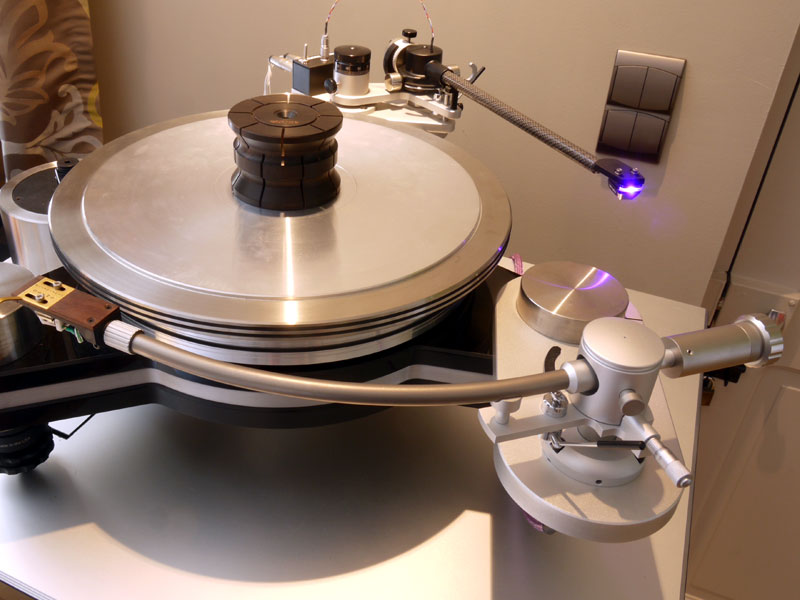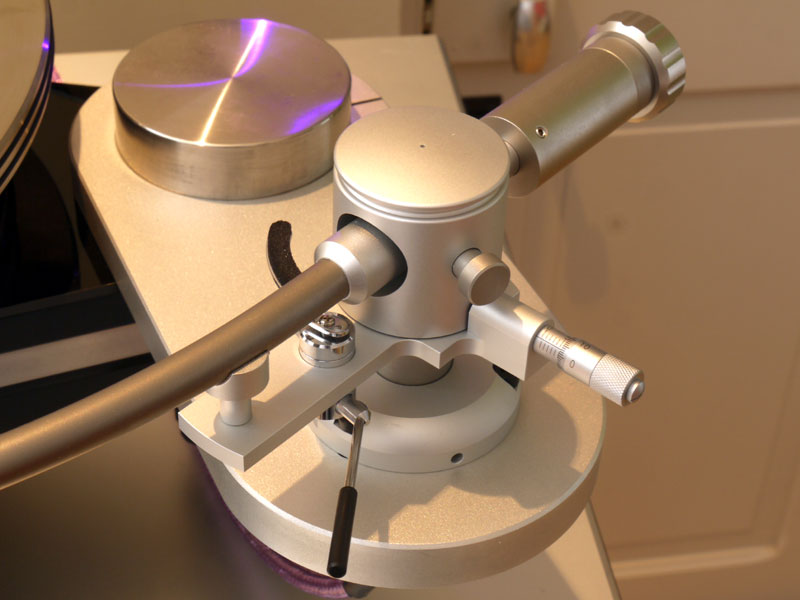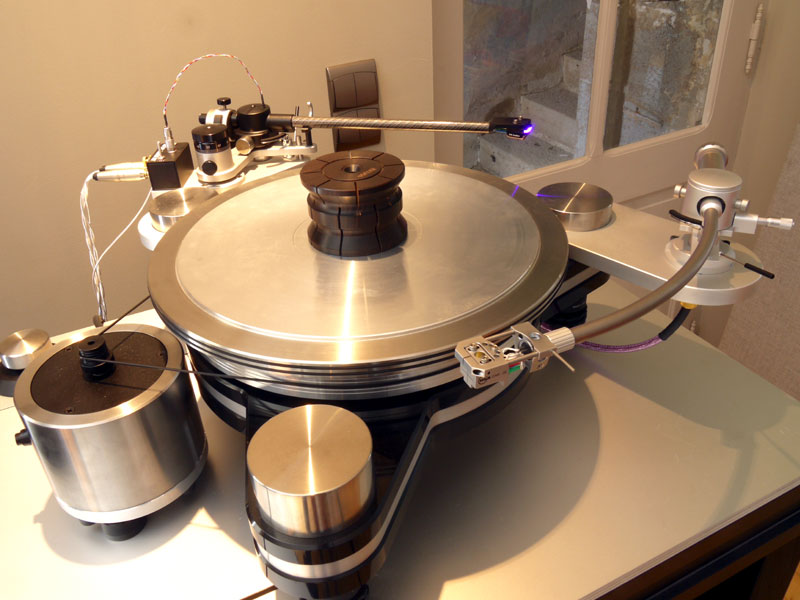First Sounds: Timestep T-612
Yet, as tonearms in general seem to be getting longer and cartridge compliance seems to be dropping, the fan base for those older, heavyweight 'arm designs also seems to be growing, despite the upward pressure that puts on prices, especially for used 'arms. Which brings me to the Timestep tonearm, latest entry into this esoteric field, an 'arm that certainly seems to tick all of those traditional boxes, yet does so at what looks like a distinctly bargain price. Take one look at the Timestep, especially the 12" T-612, and you could be forgiven for thinking it’s a vintage design. Take a second look and you realize that it actually doesn’t quite fit the mold -- which is when it dawns on you that, unlike the majority of curved 'arms, the Timestep is neither S-shaped nor J-shaped. Instead its 'armtube describes a single, gentle arc betwixt bearing housing and headshell, something that’s both distinctive and to my eyes at least, really rather attractive. You may also get a distinct feeling of déjà vu when looking at the Timestep. It looks an awful lot like an 'arm called the Audio-Creative GrooveMaster II, although looks can be deceptive. Clearly the two 'arms come from the same source, in this case Audio-Creative supplying the 'arm to Timestep’s specification. How do the two products vary? Timestep took advantage of the GrooveMaster’s excellent gimbal bearings, magnetic bias arrangement, detachable headshell and all-important titanium armtube option. After that, things start to change significantly. The GrooveMaster is actually a 12.5" tonearm, an unusual effective length to say the least. Timestep revised the length and geometry to make it a more normal 12" design. Then they added 10" and 9" options too. They fit a proprietary silver internal wire as standard and also improved the DIN connector in the armbase, using a gold-pinned, Teflon-bodied male socket. Finally, they offer a choice of a Linn-geometry mounting collar or a beefed-up mount to fit SME armboards, either option offering a serious step up in mechanical integrity. By now you might well be wondering just what this "bargain" actually costs -- and the answer is, that depends. The Timestep 'arms cost £1450 in the UK, irrespective of length, a price that includes 20% sales tax. What that doesn’t include is your choice of armmount (£50 for the Linn collar, £150 for the SME pattern), a headshell (Timestep reasons that many of their purchasers will either already own headshells or be wishing to use one of the Ortofon SPU integrated designs; if not, they have a range stretching from around £10 to £300), or a tonearm cable. So the exact cost of the Timestep depends on the options you choose and what bits and bobs you already own. With more than a few to choose from in my own spares drawer, I had no hesitation in reaching straight for the Acoustical Systems Arché headshell (£445), the perfect choice on both practical and aesthetic grounds: the silver Arché matches the 'arm perfectly, while also affording an SRA/VTA facility. For the cable, I used a Nordost Blue Heaven ($400) -- exactly the kind of quality but cost-effective cable I’d expect to be paired with the Timestep -- and a Frey 2 ($840) -- to find out just how good this 'arm really is.
Installing the Timestep on the VPI Avenger, with its skeletal construction and rotating 'armboards, was simplicity itself. The 'arm’s 290mm pivot-to-spindle distance was easily accommodated and the center dimple in the top of the cylindrical bearing housing made for quick and precise location. The 'arm comes with a laminated-card, two-point Lofgren A protractor, a sensible failsafe option, but I opted to use the SMARTractor instead, giving the Timestep exactly the same treatment I lavish on all my other tonearms. Cartridge choice for this initial listening was the Kuzma CAR-20, exactly the sort of heavyweight, low-compliance cartridge the Timestep was designed to match. I could have used an older Koetsu or one of the various Denon DL-103s that I have, but I rejected the former on the grounds of rarity, and the latter because, although I can see more than a few of the venerable Denons finding their way into Timestep 'arms, I don’t think it’s a cartridge that will really stretch its performance. The choice of the Kuzma cartridge also leads directly to the one question mark I have over the Timestep’s design -- the counterweight. There’s no denying the attractive appearance and retro chops of the long, cylindrical weight, with its profiled end-cap fitted to the Timestep, an arrangement inherited from the original GrooveMaster design. It rates high for practicality too, with the various weights provided configurable for counterweight masses between 95 and 210 grams, a sensible range given the likely partnering cartridges. But conventional wisdom is that the counterweight’s center of mass should be placed as close to the bearings as possible, thus minimizing inertia -- one box the Timestep clearly fails to tick. The counterweight itself is also a simple sliding design, a sleeve over a smooth stub, which can be locked using a small grub screw. It works, but when it comes to making the tiny adjustments in down force that make or break analog performance, a fine-pitch-threaded weight is far more repeatable and precise. Timestep is aware of both issues and an alternative counterweight design is in the works. On the plus side, the Timestep tonearm offers both azimuth adjustment and a precisely adjustable bias setting, via a micrometer-style knob. Together these offer significant setup benefits over fixed-headshell designs with klutzy bias arrangements, so make sure you take advantage of them. The musical benefits are clearly audible. But as handsome as the Timestep looks once installed -- and it is a handsome beast -- the proof of the pudding lies in the performances it reproduces. With all the necessary alignments carried out it was time to play, time to discover whether the Timestep is as musically interesting as it looks. It quickly became apparent that, musically speaking, this 'arm is both a hit and a chip off the old block. Those older Japanese 'arms are revered for their calm, unflappable stability and sense of musical flow, qualities the Timestep has clearly taken to its heart. Its arrival coincided with a trawl through a slew of neglected albums from my misspent youth, a varied parade of rock, pop and country, of albums that sound great and records that, frankly, don’t. The Timestep’s musical generosity allowed me to play the lot, wallowing in a mixture of great music and nostalgia. It was a heady brew. The T-612 sounds big, solid, stable and purposeful. There’s nothing static or heavy about its sense of weight and presence. Give it a rhythm to get its teeth into and you can sit back and enjoy the ride. One of the first tracks I played was "Paper In Fire" (from John John Cougar Mellencamp’s Lonesome Jubilee, in this instance, the MoFi 200-gram pressing [Mobile Fidelity MFSL 1-222]), and the Timestep delivered its pushy, insistent rhythm with real pace and drive, presence and energy. The song was big and strong, and there was absolutely no doubt where it was heading. The band was tight and the vocals and harmonies beautifully captured. Yet, moving on to the more reflective "Check It Out," I found that the 'arm effortlessly mastered the change of tone and pace, capturing the new mood of this very different song. Part of that sense of flow and momentum comes from the 'arm’s solid presence, which, described another way, might be considered a lack of spatial focus and transparency, a slight softness or rounded presentation. All of the above are fair comments, but the Timestep makes up for the lack of spatial separation with its tonal neutrality and rich harmonics, qualities that bring clarity to the tonal separation or identification of voices or instruments. Likewise, the slight lack of immediacy reinforces the sense of musical presence and connection, pattern and shape. With Elvis Costello’s Armed Forces [Radar Records RAD14], the Timestep again brought the often dense mixes to life. The insistent rhythm and sudden percussive interjections of "Green Shirt" had real musical impact, while the power-pop drum and bass patterns of "Party Girl" were impressively infectious. Above it all flowed Costello’s unmistakably nasal and sardonic vocals, the biting messages clear and precise, reminding me exactly why this was both such an influential album and so clearly an album of its time. But when it comes to diction and articulation, look no further than the challenge presented by Dylan’s Blood on the Tracks [Columbia 69097]. Both "Tangled Up in Blue" and the busy romp of "Lily, Rosemary and the Jack of Hearts" are delivered with clarity and purpose, but it was here that I started to run up against resolution issues. Although Dylan’s phrasing and the meter of his rhymes were spot on, his slurred and muffled diction was a bridge too far for the Timestep/Kuzma combination, the cartridge’s substance and energy being just the ticket, but its relative lack of detail echoing the character of the tonearm just a little too closely for musical comfort. The CAR-40 should prove a far more capable match and one I’d love to investigate. Switching up to the similarly solid and mechanically demanding Lyra Titan i cartridge delivered just the injection of transparency and definition required. The pace and drive remained intact, but now Dylan’s sense and singing were effortlessly unraveled for the listener’s ear, while the change of mood and tempo for "If You See Her Say Hello" was captured perfectly. It’s this ability to reveal the musical heart and nature in recordings that attracts listeners to those older traditional 'arms like the Fidelity Research models -- and it’s an ability that has been captured and incorporated into the Timestep’s performance too. But, unlike those early 'arms, although the Timestep surrenders resolution and sheer detail to more modern designs, it is nowhere near as dynamically compressed or rounded off as its forebears. Introducing the Titan i into the equation clearly demonstrated just where that glass ceiling is set, and it’s a lot higher than you might suspect. In this 'arm, the loss of ultimate detail is a question of emphasis rather than a (potentially) fatal flaw, and I’ll take the Timestep’s sense of musical purpose and integrity over the dubious attractions of a little extra definition any day. I might have started out on an unadulterated diet of pop and rock, but the very qualities that make the Timestep work in that context apply to classical recordings with an equal vengeance. Play the Karajan/BPO Dvorak Symphony No.9 [Deutsche Grammophon Gesellschaft SLPM 138922] -- via Teldec EQ, courtesy of the CH Precision I1 integrated amp) and the power and intensity, the concentrated purpose in the Berliner’s ensemble playing, are impressively apparent. The orchestral spread is good, as is depth, although I could wish for better definition of soundstage boundaries. But what really matters is the nature of the performance, and here the Timestep doesn’t disappoint, clearly revealing von Karajan’s stolid opening tempo, his distinctly Teutonic phrasing. Contrast that with Kertesz on Decca [SXL 2289] with its lyrical quality, easy ebb, flow and changes in pace, and it quickly becomes apparent that one thing this 'arm doesn’t compress or diminish is the difference between different orchestras and their performances. Once again, that sense of inner musical rightness, the ability to get tempo and phrasing right, to get energy and emphasis in the right places, delivers a musical integrity that trumps any perceived sonic shortcomings. But what further playing also reveals is that, perhaps not surprisingly, different headshells also impact the presentation -- and not in a simple "good, better, best" way. Swapping shells will, of course, alter the nature of the cartridge interface, but it will also impact on the effective mass of the 'arm and the resulting resonant behavior of the cartridge/'arm combination. As much as the very-low-compliance Kuzma loved the Acoustical Systems Arché, the Titan i actually sounded more settled in the lighter Isokinetik composite wood/magnesium headshell. Likewise, swapping cables brought obvious changes in performance, the musical and sonic benefits of the Frey 2 over the Blue Heaven being brutally apparent.
Clearly there are many options to be investigated and choices to be made, not least by those considering the purchase of a Timestep. In that sense, it’s hard to pin down the performance of the 'arm as it is something of a movable feast. But no matter what headshell or cable I used, its essential character shone through, as it delivered music with substance, energy, presence and color, plenty of drive and an infectiously toe-tapping rhythmic quality. Ancillary choice will lean the performance one way or another, and cartridge choice the same but more so, but the Timestep’s engaging musicality will remain a constant. That -- and its ability as an audio shape-shifter -- makes the Timestep as interesting as its price makes it attractive. No 'arm will ever be all things to all
men and this one is no exception. What it offers is both an affordable and versatile
12" 'arm (with shorter options too) combined with a musical perspective that is
quietly gaining attention, especially amongst owners of vintage transcription
‘tables. But to see the Timestep as a cheap alternative to vintage Japanese jewelry,
suited only to elderly Garrard or Thorens decks, is to seriously underestimate its musical
qualities and appeal. This is an 'arm that could grace many different ’tables, either
in a primary or secondary role. I’ve enjoyed my brief introduction enough to look
forward to spending some serious time working my way through the options. One thing’s
for certain: the sheer variety of alternatives might prove tedious -- except that
listening with the Timestep is never, ever less than fun. This is one 'arm whose
performance makes it as welcome as it is different to the prevailing norms. |



